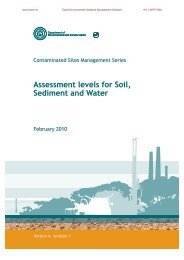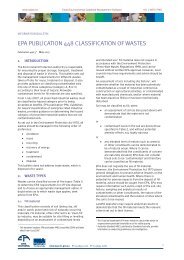Soil Generic Assessment Criteria for Human Health Risk ... - ESdat
Soil Generic Assessment Criteria for Human Health Risk ... - ESdat
Soil Generic Assessment Criteria for Human Health Risk ... - ESdat
Create successful ePaper yourself
Turn your PDF publications into a flip-book with our unique Google optimized e-Paper software.
www.esdat.net Esdat Environmental Database Management Software +61 2 8875 7948<br />
Dichloromethane<br />
TDI inhal<br />
Organisation<br />
Study type Description Response Reference Web link<br />
International Programme on Chemical Safety<br />
(IPCS)<br />
Joint Expert Committee on Food Additives<br />
(JECFA)<br />
WHO Air Quality guidelines <strong>for</strong> Europe<br />
As WHO As WHO As WHO As WHO As WHO<br />
As WHO As WHO As WHO As WHO As WHO<br />
Linear extrapolation from Divecenzo and<br />
Kaplan (1981) - <strong>Human</strong> study of vapour<br />
intake<br />
<strong>Human</strong>s exposed to doses between 175-Critical effect linked to the accumulation of<br />
700mg/m3 <strong>for</strong> 7.5 hours - exhaled<br />
vapours were analysed to allow<br />
estimation of biotrans<strong>for</strong>mation<br />
carboxyhaemoglobin (COHb) to unsafe<br />
levels (3%). The recommended value of<br />
3mg/m3 is predicted to cause a 0.1%<br />
increase in COHb<br />
WHO Regional Office <strong>for</strong> Europe, Copenhagen, Denmark. 2000, Air Quality<br />
Guidelines 2nd Edition Primary study reference: Divecenzo GD and Kaplan CJ<br />
(1981): Effect of exercise or smoking on the uptake, metabolism and excretion<br />
of methylene chloride vapour by humans. Toxicol Appl Parmacol 59, 141-148<br />
http://www.euro.who.int/document/aiq/5_7dichloromethane.pdf<br />
Dutch National Institute <strong>for</strong> Public <strong>Health</strong> and<br />
the Environment (RIVM) Maximum<br />
Permissible <strong>Risk</strong> (MPR) levels<br />
RIVM have adopted WHO approach. See<br />
above<br />
RIVM have adopted WHO approach.<br />
See above<br />
RIVM have adopted WHO approach. See<br />
above<br />
RIVM Report 711701 025. Re-evaluation of human toxicological maximum<br />
permissible risk levels A.J. Bars, R.M.C Theelan, P.J.C.M. Janssen, J.M. Hesse,<br />
M.E. van Apeldoorn, M.C.M. Meijerink, L.Verdam, M.J.Zeilmaker March 2001<br />
http://www.rivm.nl/bibliotheek/rapporten/711701025.pdf<br />
US Agency <strong>for</strong> Toxic Substances and Disease<br />
Registry (ATSDR) Toxicological Profiles and<br />
Minimal <strong>Risk</strong> levels<br />
Chronic inh. To determine NOAEL<br />
To determine a NOAEL <strong>for</strong> toxicity and<br />
carcinogenicity exposure<br />
concentrations of 0, 50, 200 and<br />
500ppm selected. Sprague Dawley Rats<br />
exposed <strong>for</strong> 6hrs/day and 5 days/week<br />
<strong>for</strong> 2 years. NOAEL of 50 ppm identified<br />
and used to determine MRL<br />
Liver: Hepatocellular cytoplasmic<br />
vacuolisation consistent with fatty changes<br />
and multinucleated hepatocytes<br />
Nitsche KD, Burek JD, Bell TJ, et al 1988a. Methylene Chloride: A 2-year<br />
inhalation toxicity and oncogenicity study in rats. Fundam Appl Toxic 11:60-67.<br />
http://www.atsdr.cdc.gov/toxprofiles/tp14-a.pdf<br />
ATSDR 2<br />
Acute symptoms associated with<br />
oxygen deprivation as a result of<br />
carboxyhaemoglobin accumulation<br />
No Info<br />
http://www.atsdr.cdc.gov/MHMI/mmg14.pdf<br />
ID oral<br />
Organisation<br />
Study type Description Response Reference Web link<br />
USEPA Integrated <strong>Risk</strong> In<strong>for</strong>mation System<br />
(IRIS)<br />
Toxicology Data Network (Toxnet)<br />
mouse/B6C3F1 B6C3F1 mice received 0, 60, 125, 185,<br />
or 250 (mg/kg)/day of dichloromethane<br />
in drinking water. Treatment groups<br />
consisted of 50 female mice and 200,<br />
100, 100, and 125 male mice (low to<br />
high dose). One hundred females and<br />
125 males served as controls.<br />
See IRIS data See IRIS data See IRIS data<br />
Male mice had an increased incidence of<br />
combined neoplastic nodules and<br />
hepatocellular carcinoma (24/125, 51/200,<br />
30/100, 31/99, 35/125). The increase was<br />
not dose-related, but the pair wise<br />
comparisons <strong>for</strong> the two mid- dose groups<br />
were reported to be statistically significant<br />
(U.S. EPA, 1985a). The hepatocellular<br />
carcinoma incidence alone <strong>for</strong> male mice<br />
(which was about 55 to 65% of the total)<br />
was not significantly elevated.<br />
NCA (National Coffee Association). 1983. Twenty-four month oncogenicity<br />
study of methylene chloride in mice. Final Report. Prepared by Hazleton<br />
Laboratories, America, Inc., Vienna, VA.<br />
http://toxnet.nlm.nih.gov/cgi-bin/sis/search/f./temp/~ic5Vi3:1<br />
http://toxnet.nlm.nih.gov/cgi-bin/sis/search/f./temp/~ic5Vi3:1<br />
Page 4 of 6 EIC Pro<strong>for</strong>ma dichloromethane.xls 28/08/2009








